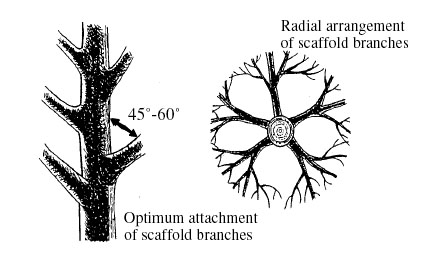
Are you wondering when to prune your trees and shrubs?
Although the caller was asking specifically about when to prune a redbud tree, the response is applicable to most shrubs and trees. Here are some pruning basics for trees. Scroll down for some excellent links about when and how to prune.
Q. When to prune my Redbud?
We’re wondering about a Canada Redbud Tree. We planted it last year when it was a small size. It needs pruning now as it has long outward growing branches, no distinct main trunk. Do we need to wait till it blooms this year before we can prune? How do we encourage upward growth & a better shape?
A. Not in Fall – More Tips about When and How
Timing – If you can live without blooms for one year, it’s usually best to prune a tree in the spring while still dormant; ensuring you wait until temperatures will be above freezing for at least a day or two.
Not only can you clearly see the shape of the branches at this time, but it’s also best for the tree’s health to have such work done while it’s not bearing leaves or in growth mode.
You definitely do NOT want to do this pruning in the fall. Avoid creating a relatively new wound that will not heal well enough to withstand the cold winter elements. Fall pruning will result in additional die-back.
How to prune – here are a few basics to get you started:
1) Do not TOP any branches (lopping off an end) or it will spoil the tree forever.
2) Do careful pruning cuts very close to where a chosen branch meets another main branch or trunk but not slicing away an excessive amount of bark.
3) Don’t take more than 30% of the branches or foliage in one year…that’s what feeds the tree and will help it recover.
4) Check for and remove any broken, rubbing, crossed, or seriously weak crotches (V-shaped). These issues are relatively unlikely in a redbud but are something to look for and deal with sooner rather than later.
5) To develop upright growth you need a strong leader (which you may encourage by removing competitors and loosely tying the chosen one with a soft tie and a stake).
6) Your second goal is to select which will be the strong, relatively symmetrical scaffold branches for the long-term and protect them while gradually over the next few years removing other branches. Consider also where you want the tree to start branching from …ie do you wish to raise the point where the tree starts branching out to allow underneath seating or perennials or a lawnmower to run under it? Keeping in mind point number 3, start pruning out those lower branches as needed. Don’t overdo it or you’ll get a top-heavy tree that’s more prone to breakage.

Click these resources to learn more:
Ontario Ministry of Natural Resources – advice re pruning, esp oaks!
University of Virginia – Guide to Successful Pruning of Deciduous Trees
The Iowa Gardener – How to Prune a Small Tree
The University of Minnesota – Pruning Trees and Shrubs, and Pruning Shade Trees
Harlequin Gardens – Pruning and Care of Young Trees





About The Author: Armstrong
As an author and editor, Linda directs her lifelong love of nature and plants to concerns about our environment and how we can do better. In addition to decades of gardening experience, and training as a master gardener, Linda focuses on learning from leading science-based educators and writers, and in the process finds that she uncovers many gardening myths.
More posts by Armstrong